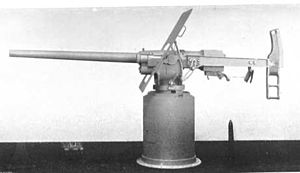QF 6-pdr 8 cwt naval gun
| QF 6 pounder Hotchkiss | |
|---|---|

Early Elswick gun on recoil mounting
|
|
| Type | |
| Place of origin | France |
| Service history | |
| In service | 1885–1940s |
| Used by | |
| Wars | |
| Production history | |
| Designer | Hotchkiss et Cie |
| Designed | 1883 |
| Number built | 3,984 (UK) |
| Specifications | |
| Weight | 821–849 lb (372–385 kg) barrel & breech |
| Barrel length | various. 40–58 calibres |
|
|
|
| Shell |
|
| Calibre | 57-millimetre (2.244 in) |
| Breech | Vertical sliding block |
| Recoil | Hydro-spring, 4 inch |
| Rate of fire | 25 / minute |
| Muzzle velocity | 1,818 feet per second (554 m/s) |
| Effective firing range | 4,000 yards (3,700 m) |
The QF 6 pounder Hotchkiss was a light 2.24 inch (57 mm) naval gun and coast defence gun of the late 19th century used by many countries, and was adapted for use in the early British tanks in World War I.
The UK adopted a 40-calibre (i.e. 90 inch barrel) version as Ordnance QF Hotchkiss 6 pounder gun Mk I and Mk II or QF 6 pounder 8 cwt. It was manufactured under licence by the Elswick Ordnance Company.
They were originally mounted for use against the new (steam-driven) torpedo boats which started to enter service in the late 1870s.
The original 1885 Mk I lacked a recoil system. The Mk II of 1890 introduced a recoil system, with a pair of recoil/recuperator cylinders.
During World War I the navy required many more guns and a version with a single-tube barrel was developed to simplify manufacture, identified as "6 pdr Single Tube". Initially these guns were only allowed to be fired with a special lower charge but in 1917 they were relined with A tubes as Mk I+++ which enabled them to use the standard 6 pounder ammunition.
After World War I the gun was considered obsolete for combat use, but continued in use as a saluting gun and as a sub-calibre training gun. Of the 3,984 produced it was estimated that 1,640 still existed in 1939. With the onset of World War II the remaining guns were rushed back into service for anti-submarine defense, E-boat defense and for coastal defense. New non-recoil Mk VI, Mk VI* and Mk VI** mountings were built with elevations between -10° to +70°. These mountings were used on early models of the Fairmile D Motor Gunboats, Motor Launchs and Flower-class corvettes. Some of which were not re-armed with the modern auto-loading 6 pdr Mk IIA until late 1944.
The gun was used to equip Male versions of the early British tanks, Mk I - Mk III. In 1916 the British Army having no prior experience in fighting tanks was faced with the difficulty of quickly providing a new class of weapon. The existing Hotchkiss 6 pounder naval gun appeared to most closely meet the need (a compact enough weapon to fit into a tank sponson with a sufficient delivery of high explosive). A single gun was mounted in each sponson, i.e. 2 per Male tank (tanks armed only with machine guns were designated Female), able to fire forwards or to the side.
...
Wikipedia
